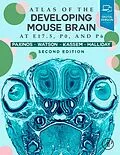Atlas of the Developing Mouse Brain, Second Edition builds on the features of successful first edition, providing a comprehensive and convenient reference for all areas of the mouse brain at Fetal-Day 17.5 (E17.5), Day-of-Birth (P0), and Day-Six postnatal (P6). The book also delineates the parts of the eye, features of the skull, ganglia, nerves, arteries, veins, bones and foramina. This atlas is an essential tool for researchers and students who study the development of the mouse brain, or for those who interpret findings from genetic manipulation. - Contains 176 high-resolution color scans of Nissl-stained coronal sections of the brain and skull of the fetal (E17.5), day-of-birth (P0), and day-six postnatal mouse (P6) - Includes diagrams that delineate all structures of the brain, as well as peripheral nerves, ganglia, muscles, bones, veins and arteries of the head - Presents approximately 5000 corrections and updates from the first edition - Includes color codes of the veins, arteries, nerves and ganglions of the skull in diagrams
Autorentext
Professor George Paxinos, AO (BA, MA, PhD, DSc) completed his BA at The University of California at Berkeley, his PhD at McGill University, and spent a postdoctoral year at Yale University. He is the author of almost 50 books on the structure of the brain of humans and experimental animals, including The Rat Brain in Stereotaxic Coordinates, now in its 7th Edition, which is ranked by Thomson ISI as one of the 50 most cited items in the Web of Science. Dr. Paxinos paved the way for future neuroscience research by being the first to produce a three-dimensional (stereotaxic) framework for placement of electrodes and injections in the brain of experimental animals, which is now used as an international standard. He was a member of the first International Consortium for Brain Mapping, a UCLA based consortium that received the top ranking and was funded by the NIMH led Human Brain Project. Dr. Paxinos has been honored with more than nine distinguished awards throughout his years of research, including: The Warner Brown Memorial Prize (University of California at Berkeley, 1968), The Walter Burfitt Prize (1992), The Award for Excellence in Publishing in Medical Science (Assoc Amer Publishers, 1999), The Ramaciotti Medal for Excellence in Biomedical Research (2001), The Alexander von Humbolt Foundation Prize (Germany 2004), and more.
Klappentext
Atlas of the Developing Mouse Brain, Second Edition builds on the features of successful first edition, providing a comprehensive and convenient reference for all areas of the mouse brain at Fetal-Day 17.5 (E17.5), Day-of-Birth (P0), and Day-Six postnatal (P6). The book also delineates the parts of the eye, features of the skull, ganglia, nerves, arteries, veins, bones and foramina. This atlas is an essential tool for researchers and students who study the development of the mouse brain, or for those who interpret findings from genetic manipulation.
- Contains 176 high-resolution color scans of Nissl-stained coronal sections of the brain and skull of the fetal (E17.5), day-of-birth (P0), and day-six postnatal mouse (P6)
- Includes diagrams that delineate all structures of the brain, as well as peripheral nerves, ganglia, muscles, bones, veins and arteries of the head
- Presents approximately 5000 corrections and updates from the first edition
- Includes color codes of the veins, arteries, nerves and ganglions of the skull in diagrams
Inhalt
Preface to the second edition
Reproduction of altas figures in other publications
Acknowledgements
Introduction
Histology
Preparation of photographs and drawings
The construction of abbreviations in the Paxinos/Watson nomenclature
Identification of structures
References
List of structures
Index of abbreviations
Figures
